Identifying and Evaluating Data Warehousing Trends in Healthcare
VerifiedAdded on 2023/01/12
|7
|1658
|34
Report
AI Summary
This report explores current trends in data warehousing, specifically within the context of healthcare epidemiology. It begins by identifying key trends, such as the development of large-scale cloud data warehouses, self-service data warehousing, the use of data marts, in-memory analytical engines, columnar storage, and the adoption of NoSQL databases. The report then critically evaluates these trends, highlighting the challenges of data integration and the importance of data validity and ethical considerations. The analysis references various sources, including journals and literature, to provide a comprehensive overview of the subject. The report concludes by emphasizing the significance of these trends in improving healthcare outcomes and addressing the complexities of data management in the field.
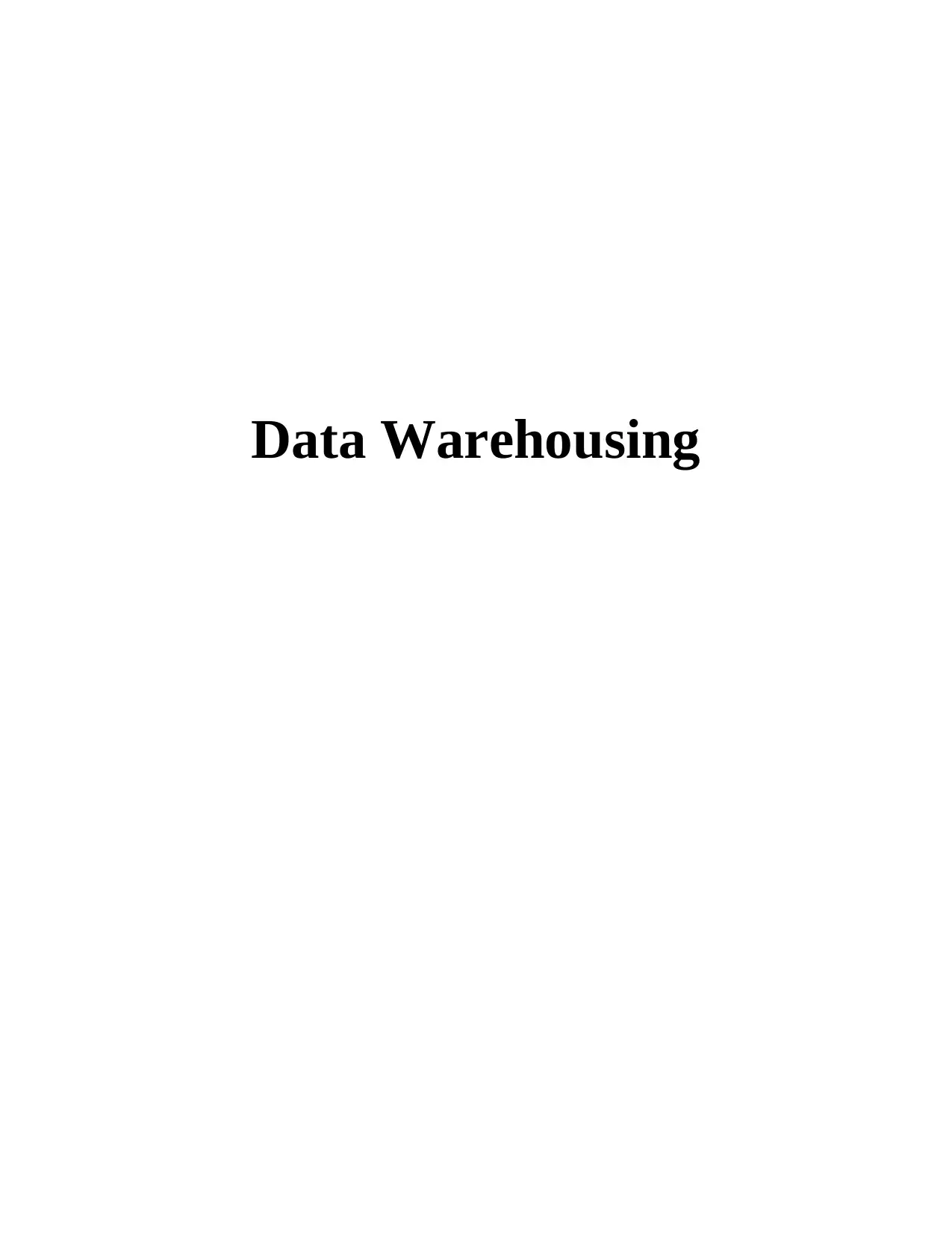
Data Warehousing
Paraphrase This Document
Need a fresh take? Get an instant paraphrase of this document with our AI Paraphraser
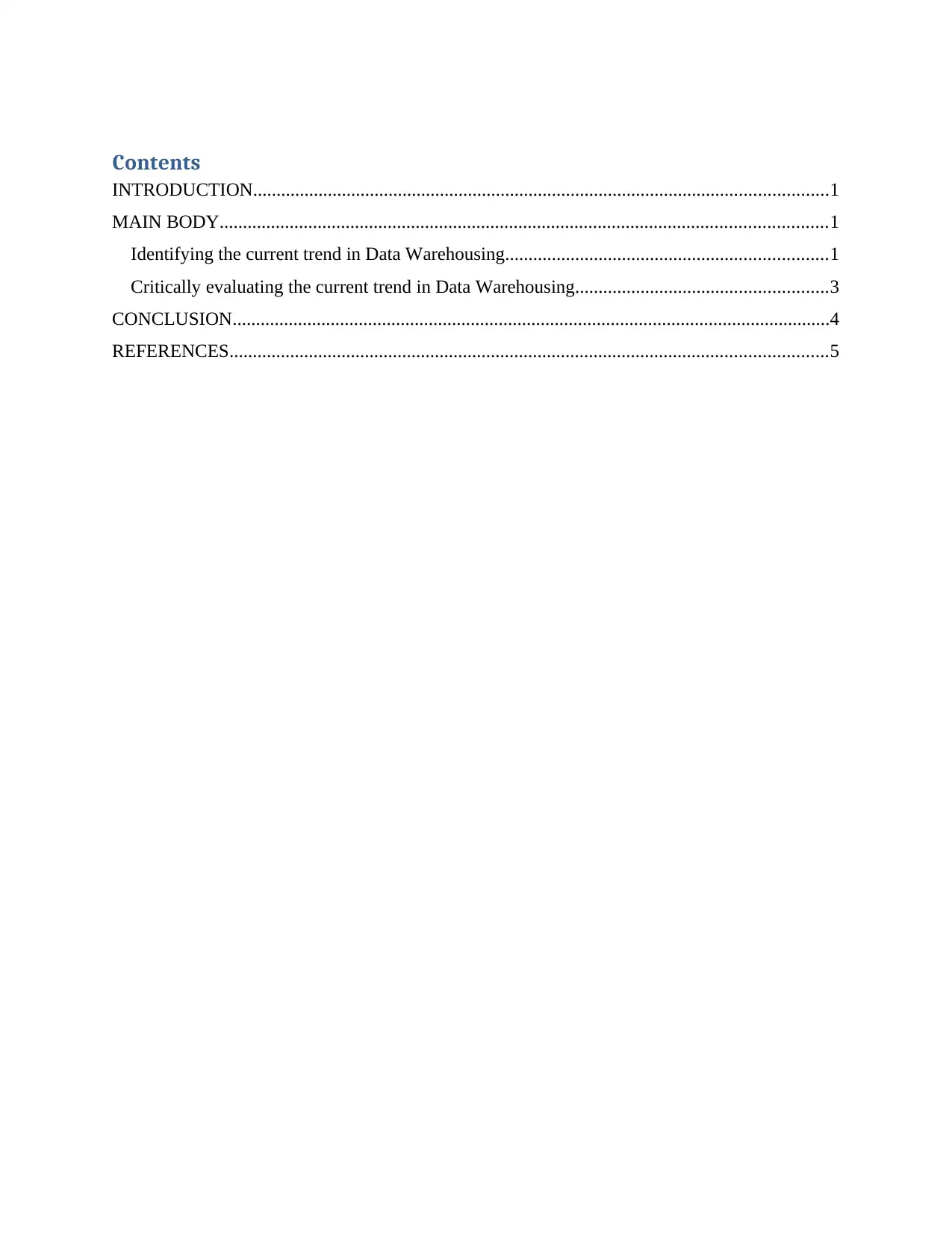
Contents
INTRODUCTION...........................................................................................................................1
MAIN BODY..................................................................................................................................1
Identifying the current trend in Data Warehousing.....................................................................1
Critically evaluating the current trend in Data Warehousing......................................................3
CONCLUSION................................................................................................................................4
REFERENCES................................................................................................................................5
INTRODUCTION...........................................................................................................................1
MAIN BODY..................................................................................................................................1
Identifying the current trend in Data Warehousing.....................................................................1
Critically evaluating the current trend in Data Warehousing......................................................3
CONCLUSION................................................................................................................................4
REFERENCES................................................................................................................................5
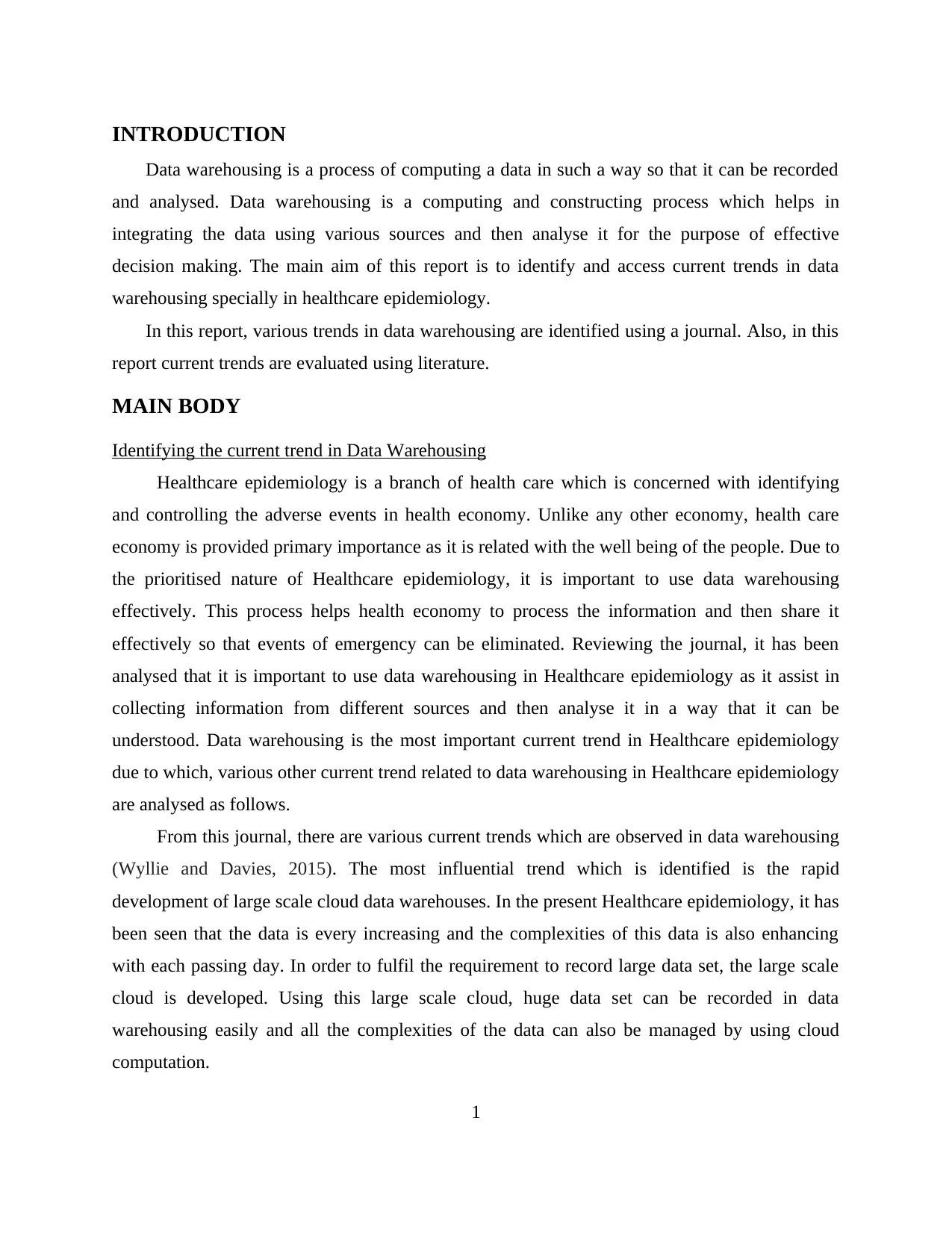
INTRODUCTION
Data warehousing is a process of computing a data in such a way so that it can be recorded
and analysed. Data warehousing is a computing and constructing process which helps in
integrating the data using various sources and then analyse it for the purpose of effective
decision making. The main aim of this report is to identify and access current trends in data
warehousing specially in healthcare epidemiology.
In this report, various trends in data warehousing are identified using a journal. Also, in this
report current trends are evaluated using literature.
MAIN BODY
Identifying the current trend in Data Warehousing
Healthcare epidemiology is a branch of health care which is concerned with identifying
and controlling the adverse events in health economy. Unlike any other economy, health care
economy is provided primary importance as it is related with the well being of the people. Due to
the prioritised nature of Healthcare epidemiology, it is important to use data warehousing
effectively. This process helps health economy to process the information and then share it
effectively so that events of emergency can be eliminated. Reviewing the journal, it has been
analysed that it is important to use data warehousing in Healthcare epidemiology as it assist in
collecting information from different sources and then analyse it in a way that it can be
understood. Data warehousing is the most important current trend in Healthcare epidemiology
due to which, various other current trend related to data warehousing in Healthcare epidemiology
are analysed as follows.
From this journal, there are various current trends which are observed in data warehousing
(Wyllie and Davies, 2015). The most influential trend which is identified is the rapid
development of large scale cloud data warehouses. In the present Healthcare epidemiology, it has
been seen that the data is every increasing and the complexities of this data is also enhancing
with each passing day. In order to fulfil the requirement to record large data set, the large scale
cloud is developed. Using this large scale cloud, huge data set can be recorded in data
warehousing easily and all the complexities of the data can also be managed by using cloud
computation.
1
Data warehousing is a process of computing a data in such a way so that it can be recorded
and analysed. Data warehousing is a computing and constructing process which helps in
integrating the data using various sources and then analyse it for the purpose of effective
decision making. The main aim of this report is to identify and access current trends in data
warehousing specially in healthcare epidemiology.
In this report, various trends in data warehousing are identified using a journal. Also, in this
report current trends are evaluated using literature.
MAIN BODY
Identifying the current trend in Data Warehousing
Healthcare epidemiology is a branch of health care which is concerned with identifying
and controlling the adverse events in health economy. Unlike any other economy, health care
economy is provided primary importance as it is related with the well being of the people. Due to
the prioritised nature of Healthcare epidemiology, it is important to use data warehousing
effectively. This process helps health economy to process the information and then share it
effectively so that events of emergency can be eliminated. Reviewing the journal, it has been
analysed that it is important to use data warehousing in Healthcare epidemiology as it assist in
collecting information from different sources and then analyse it in a way that it can be
understood. Data warehousing is the most important current trend in Healthcare epidemiology
due to which, various other current trend related to data warehousing in Healthcare epidemiology
are analysed as follows.
From this journal, there are various current trends which are observed in data warehousing
(Wyllie and Davies, 2015). The most influential trend which is identified is the rapid
development of large scale cloud data warehouses. In the present Healthcare epidemiology, it has
been seen that the data is every increasing and the complexities of this data is also enhancing
with each passing day. In order to fulfil the requirement to record large data set, the large scale
cloud is developed. Using this large scale cloud, huge data set can be recorded in data
warehousing easily and all the complexities of the data can also be managed by using cloud
computation.
1
⊘ This is a preview!⊘
Do you want full access?
Subscribe today to unlock all pages.

Trusted by 1+ million students worldwide
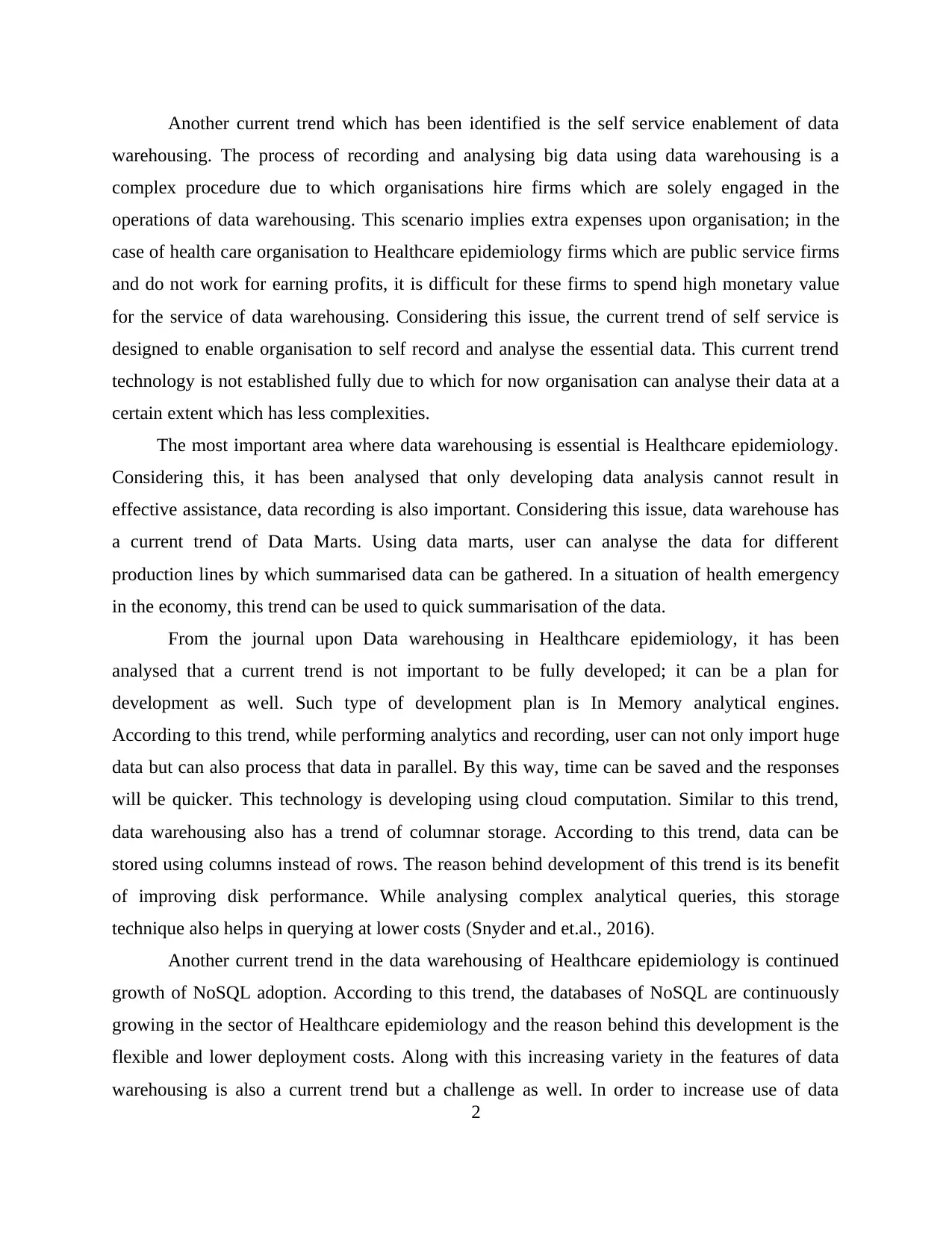
Another current trend which has been identified is the self service enablement of data
warehousing. The process of recording and analysing big data using data warehousing is a
complex procedure due to which organisations hire firms which are solely engaged in the
operations of data warehousing. This scenario implies extra expenses upon organisation; in the
case of health care organisation to Healthcare epidemiology firms which are public service firms
and do not work for earning profits, it is difficult for these firms to spend high monetary value
for the service of data warehousing. Considering this issue, the current trend of self service is
designed to enable organisation to self record and analyse the essential data. This current trend
technology is not established fully due to which for now organisation can analyse their data at a
certain extent which has less complexities.
The most important area where data warehousing is essential is Healthcare epidemiology.
Considering this, it has been analysed that only developing data analysis cannot result in
effective assistance, data recording is also important. Considering this issue, data warehouse has
a current trend of Data Marts. Using data marts, user can analyse the data for different
production lines by which summarised data can be gathered. In a situation of health emergency
in the economy, this trend can be used to quick summarisation of the data.
From the journal upon Data warehousing in Healthcare epidemiology, it has been
analysed that a current trend is not important to be fully developed; it can be a plan for
development as well. Such type of development plan is In Memory analytical engines.
According to this trend, while performing analytics and recording, user can not only import huge
data but can also process that data in parallel. By this way, time can be saved and the responses
will be quicker. This technology is developing using cloud computation. Similar to this trend,
data warehousing also has a trend of columnar storage. According to this trend, data can be
stored using columns instead of rows. The reason behind development of this trend is its benefit
of improving disk performance. While analysing complex analytical queries, this storage
technique also helps in querying at lower costs (Snyder and et.al., 2016).
Another current trend in the data warehousing of Healthcare epidemiology is continued
growth of NoSQL adoption. According to this trend, the databases of NoSQL are continuously
growing in the sector of Healthcare epidemiology and the reason behind this development is the
flexible and lower deployment costs. Along with this increasing variety in the features of data
warehousing is also a current trend but a challenge as well. In order to increase use of data
2
warehousing. The process of recording and analysing big data using data warehousing is a
complex procedure due to which organisations hire firms which are solely engaged in the
operations of data warehousing. This scenario implies extra expenses upon organisation; in the
case of health care organisation to Healthcare epidemiology firms which are public service firms
and do not work for earning profits, it is difficult for these firms to spend high monetary value
for the service of data warehousing. Considering this issue, the current trend of self service is
designed to enable organisation to self record and analyse the essential data. This current trend
technology is not established fully due to which for now organisation can analyse their data at a
certain extent which has less complexities.
The most important area where data warehousing is essential is Healthcare epidemiology.
Considering this, it has been analysed that only developing data analysis cannot result in
effective assistance, data recording is also important. Considering this issue, data warehouse has
a current trend of Data Marts. Using data marts, user can analyse the data for different
production lines by which summarised data can be gathered. In a situation of health emergency
in the economy, this trend can be used to quick summarisation of the data.
From the journal upon Data warehousing in Healthcare epidemiology, it has been
analysed that a current trend is not important to be fully developed; it can be a plan for
development as well. Such type of development plan is In Memory analytical engines.
According to this trend, while performing analytics and recording, user can not only import huge
data but can also process that data in parallel. By this way, time can be saved and the responses
will be quicker. This technology is developing using cloud computation. Similar to this trend,
data warehousing also has a trend of columnar storage. According to this trend, data can be
stored using columns instead of rows. The reason behind development of this trend is its benefit
of improving disk performance. While analysing complex analytical queries, this storage
technique also helps in querying at lower costs (Snyder and et.al., 2016).
Another current trend in the data warehousing of Healthcare epidemiology is continued
growth of NoSQL adoption. According to this trend, the databases of NoSQL are continuously
growing in the sector of Healthcare epidemiology and the reason behind this development is the
flexible and lower deployment costs. Along with this increasing variety in the features of data
warehousing is also a current trend but a challenge as well. In order to increase use of data
2
Paraphrase This Document
Need a fresh take? Get an instant paraphrase of this document with our AI Paraphraser
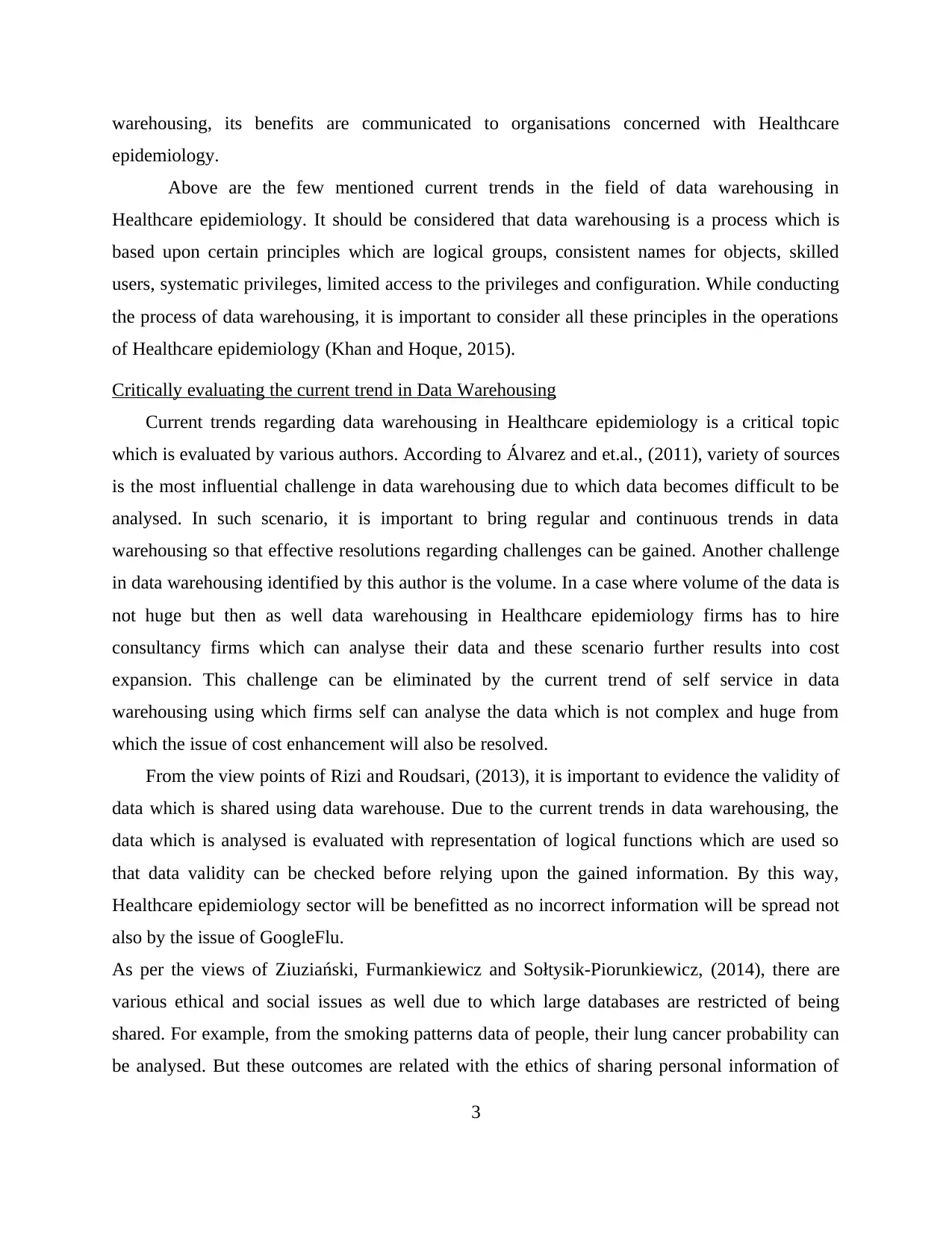
warehousing, its benefits are communicated to organisations concerned with Healthcare
epidemiology.
Above are the few mentioned current trends in the field of data warehousing in
Healthcare epidemiology. It should be considered that data warehousing is a process which is
based upon certain principles which are logical groups, consistent names for objects, skilled
users, systematic privileges, limited access to the privileges and configuration. While conducting
the process of data warehousing, it is important to consider all these principles in the operations
of Healthcare epidemiology (Khan and Hoque, 2015).
Critically evaluating the current trend in Data Warehousing
Current trends regarding data warehousing in Healthcare epidemiology is a critical topic
which is evaluated by various authors. According to Álvarez and et.al., (2011), variety of sources
is the most influential challenge in data warehousing due to which data becomes difficult to be
analysed. In such scenario, it is important to bring regular and continuous trends in data
warehousing so that effective resolutions regarding challenges can be gained. Another challenge
in data warehousing identified by this author is the volume. In a case where volume of the data is
not huge but then as well data warehousing in Healthcare epidemiology firms has to hire
consultancy firms which can analyse their data and these scenario further results into cost
expansion. This challenge can be eliminated by the current trend of self service in data
warehousing using which firms self can analyse the data which is not complex and huge from
which the issue of cost enhancement will also be resolved.
From the view points of Rizi and Roudsari, (2013), it is important to evidence the validity of
data which is shared using data warehouse. Due to the current trends in data warehousing, the
data which is analysed is evaluated with representation of logical functions which are used so
that data validity can be checked before relying upon the gained information. By this way,
Healthcare epidemiology sector will be benefitted as no incorrect information will be spread not
also by the issue of GoogleFlu.
As per the views of Ziuziański, Furmankiewicz and Sołtysik-Piorunkiewicz, (2014), there are
various ethical and social issues as well due to which large databases are restricted of being
shared. For example, from the smoking patterns data of people, their lung cancer probability can
be analysed. But these outcomes are related with the ethics of sharing personal information of
3
epidemiology.
Above are the few mentioned current trends in the field of data warehousing in
Healthcare epidemiology. It should be considered that data warehousing is a process which is
based upon certain principles which are logical groups, consistent names for objects, skilled
users, systematic privileges, limited access to the privileges and configuration. While conducting
the process of data warehousing, it is important to consider all these principles in the operations
of Healthcare epidemiology (Khan and Hoque, 2015).
Critically evaluating the current trend in Data Warehousing
Current trends regarding data warehousing in Healthcare epidemiology is a critical topic
which is evaluated by various authors. According to Álvarez and et.al., (2011), variety of sources
is the most influential challenge in data warehousing due to which data becomes difficult to be
analysed. In such scenario, it is important to bring regular and continuous trends in data
warehousing so that effective resolutions regarding challenges can be gained. Another challenge
in data warehousing identified by this author is the volume. In a case where volume of the data is
not huge but then as well data warehousing in Healthcare epidemiology firms has to hire
consultancy firms which can analyse their data and these scenario further results into cost
expansion. This challenge can be eliminated by the current trend of self service in data
warehousing using which firms self can analyse the data which is not complex and huge from
which the issue of cost enhancement will also be resolved.
From the view points of Rizi and Roudsari, (2013), it is important to evidence the validity of
data which is shared using data warehouse. Due to the current trends in data warehousing, the
data which is analysed is evaluated with representation of logical functions which are used so
that data validity can be checked before relying upon the gained information. By this way,
Healthcare epidemiology sector will be benefitted as no incorrect information will be spread not
also by the issue of GoogleFlu.
As per the views of Ziuziański, Furmankiewicz and Sołtysik-Piorunkiewicz, (2014), there are
various ethical and social issues as well due to which large databases are restricted of being
shared. For example, from the smoking patterns data of people, their lung cancer probability can
be analysed. But these outcomes are related with the ethics of sharing personal information of
3
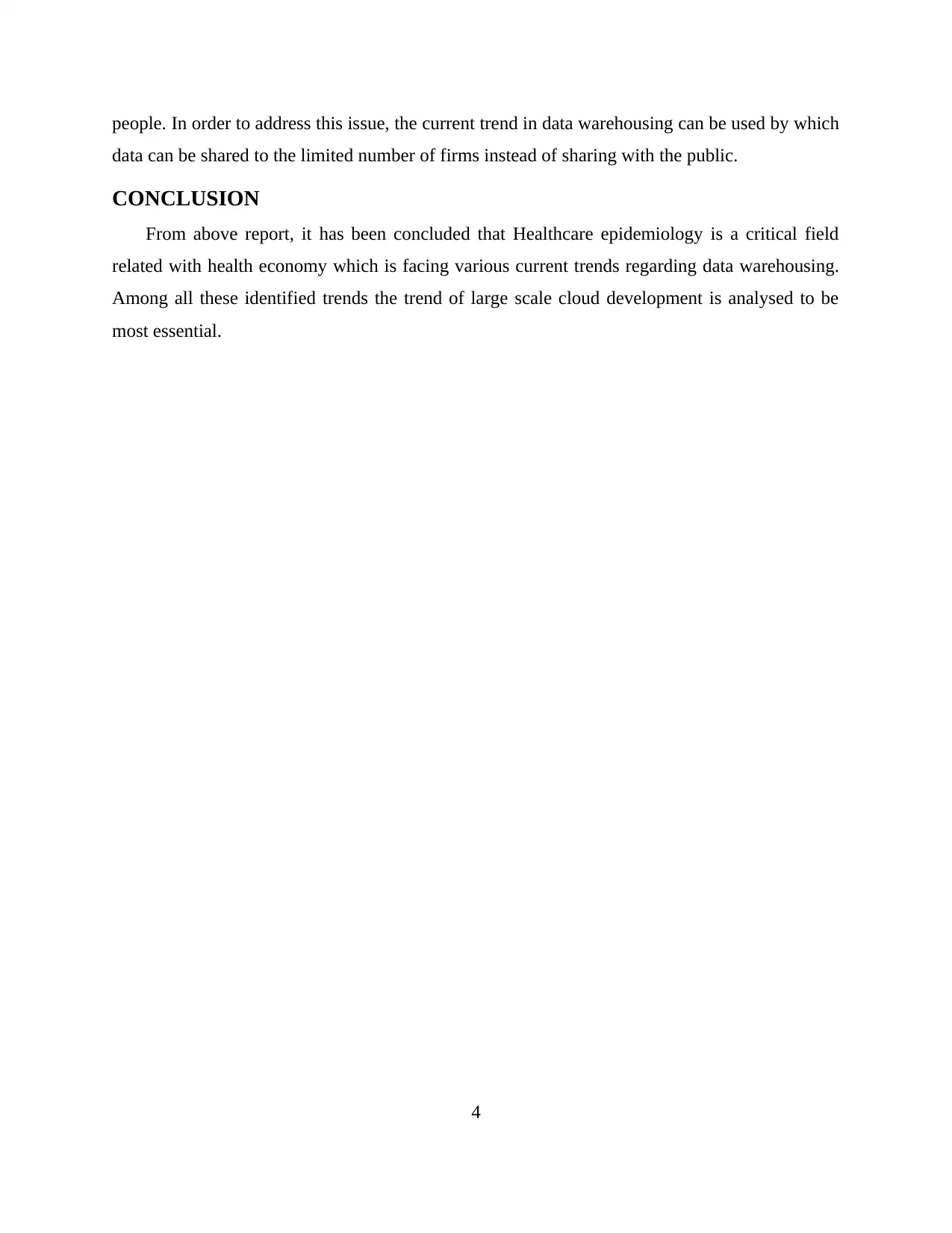
people. In order to address this issue, the current trend in data warehousing can be used by which
data can be shared to the limited number of firms instead of sharing with the public.
CONCLUSION
From above report, it has been concluded that Healthcare epidemiology is a critical field
related with health economy which is facing various current trends regarding data warehousing.
Among all these identified trends the trend of large scale cloud development is analysed to be
most essential.
4
data can be shared to the limited number of firms instead of sharing with the public.
CONCLUSION
From above report, it has been concluded that Healthcare epidemiology is a critical field
related with health economy which is facing various current trends regarding data warehousing.
Among all these identified trends the trend of large scale cloud development is analysed to be
most essential.
4
⊘ This is a preview!⊘
Do you want full access?
Subscribe today to unlock all pages.

Trusted by 1+ million students worldwide
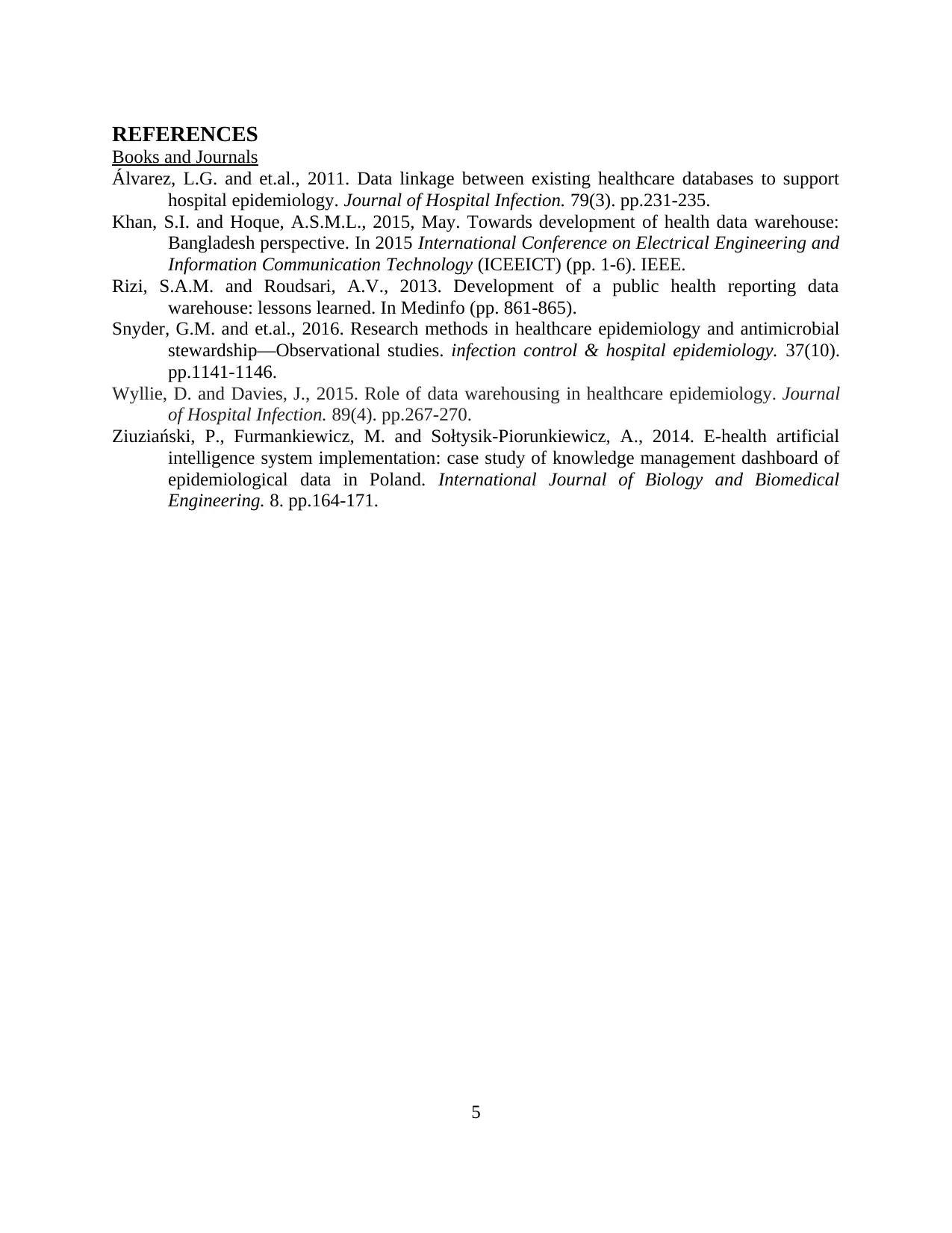
REFERENCES
Books and Journals
Álvarez, L.G. and et.al., 2011. Data linkage between existing healthcare databases to support
hospital epidemiology. Journal of Hospital Infection. 79(3). pp.231-235.
Khan, S.I. and Hoque, A.S.M.L., 2015, May. Towards development of health data warehouse:
Bangladesh perspective. In 2015 International Conference on Electrical Engineering and
Information Communication Technology (ICEEICT) (pp. 1-6). IEEE.
Rizi, S.A.M. and Roudsari, A.V., 2013. Development of a public health reporting data
warehouse: lessons learned. In Medinfo (pp. 861-865).
Snyder, G.M. and et.al., 2016. Research methods in healthcare epidemiology and antimicrobial
stewardship—Observational studies. infection control & hospital epidemiology. 37(10).
pp.1141-1146.
Wyllie, D. and Davies, J., 2015. Role of data warehousing in healthcare epidemiology. Journal
of Hospital Infection. 89(4). pp.267-270.
Ziuziański, P., Furmankiewicz, M. and Sołtysik-Piorunkiewicz, A., 2014. E-health artificial
intelligence system implementation: case study of knowledge management dashboard of
epidemiological data in Poland. International Journal of Biology and Biomedical
Engineering. 8. pp.164-171.
5
Books and Journals
Álvarez, L.G. and et.al., 2011. Data linkage between existing healthcare databases to support
hospital epidemiology. Journal of Hospital Infection. 79(3). pp.231-235.
Khan, S.I. and Hoque, A.S.M.L., 2015, May. Towards development of health data warehouse:
Bangladesh perspective. In 2015 International Conference on Electrical Engineering and
Information Communication Technology (ICEEICT) (pp. 1-6). IEEE.
Rizi, S.A.M. and Roudsari, A.V., 2013. Development of a public health reporting data
warehouse: lessons learned. In Medinfo (pp. 861-865).
Snyder, G.M. and et.al., 2016. Research methods in healthcare epidemiology and antimicrobial
stewardship—Observational studies. infection control & hospital epidemiology. 37(10).
pp.1141-1146.
Wyllie, D. and Davies, J., 2015. Role of data warehousing in healthcare epidemiology. Journal
of Hospital Infection. 89(4). pp.267-270.
Ziuziański, P., Furmankiewicz, M. and Sołtysik-Piorunkiewicz, A., 2014. E-health artificial
intelligence system implementation: case study of knowledge management dashboard of
epidemiological data in Poland. International Journal of Biology and Biomedical
Engineering. 8. pp.164-171.
5
1 out of 7
Related Documents
Your All-in-One AI-Powered Toolkit for Academic Success.
+13062052269
info@desklib.com
Available 24*7 on WhatsApp / Email
![[object Object]](/_next/static/media/star-bottom.7253800d.svg)
Unlock your academic potential
Copyright © 2020–2025 A2Z Services. All Rights Reserved. Developed and managed by ZUCOL.





